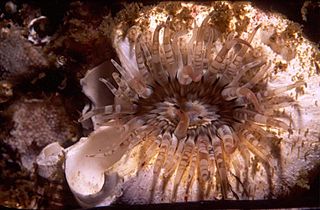
The Sipuncula or Sipunculida is a class containing about 162 species of unsegmented marine annelid worms. Sipuncula was once considered a phylum, but was demoted to a class of Annelida, based on recent molecular work.

Cucumaria miniata is a species of sea cucumber. It is commonly known as the orange sea cucumber or red sea cucumber due to its striking color. This northeast Pacific species is often found wedged in between rocks or crevices at the coast or on docks and can generally be identified by its orange bushy tentacles protruding above the substrate.

Golfingia vulgaris is a marine invertebrate belonging to the phylum Sipuncula, the peanut worms. It is a cylindrical, unsegmented worm with a crown of tentacles around the mouth. It lives in burrows in shallow seas in various parts of the world.

Sipunculus nudus is a cosmopolitan species of unsegmented marine worm of the class Sipuncula, also known as peanut worms.

Themiste is a genus of peanut worms. It is the only genus in the family Themistidae.

Golfingiida, also known as the Golfingiiformes, is an order of peanut worms. The tentacles form a circle around the mouth, while those of the sister taxon, Phascolosomatidea, are only found above the mouth. Most species burrow in the substrate but some live in the empty shells of gastropods. It is an order of the class Sipuncula, and contains the following families:
Phascolopsis gouldii is a species of unsegmented benthic marine worm, also known as a peanut worm or star worm. It lives in burrows in muddy sand in shallow waters off North America.

The ring-tentacle anemone is a species of sea anemone in the family Isanthidae.

Sabella spallanzanii is a species of marine polychaete worms in the family Sabellidae. Common names include the Mediterranean fanworm, the feather duster worm, the European fan worm and the pencil worm. It is native to shallow waters in the northeastern Atlantic Ocean and the Mediterranean Sea. It has spread to various other parts of the world and is included on the Global Invasive Species Database maintained by the IUCN.

Eupentacta quinquesemita is a species of sea cucumber, a marine invertebrate with an elongated body, a leathery skin and tentacles surrounding the mouth. It is commonly known as the stiff-footed sea cucumber or white sea cucumber, and occurs on rocky coasts in the northeastern Pacific Ocean.
Nephasoma minutum is a marine invertebrate of the phylum Sipuncula, commonly known as peanut worms because of their shape when contracted. It is a cylindrical, unsegmented worm with a crown of tentacles around the mouth. These worms live in crevices in the rocks or in burrows in shallow water in Western Europe, and the eastern United States.
Nephasoma rimicola is a marine invertebrate belonging to the phylum Sipuncula, the peanut worms. This worm occurs in the northeastern Atlantic Ocean.
Phascolosoma granulatum is a species of peanut worm in the family Phascolosomatidae. It is found in shallow water in the northeastern Atlantic Ocean and the Mediterranean Sea.

Serpula columbiana, variously called the calcareous tubeworm, plume worm, fan worm, limy tube worm and red tube worm, is a species of segmented marine polychaete worm in the family Serpulidae. It is a cosmopolitan species that is found in most seas in the Northern Hemisphere including the Atlantic Ocean, the Pacific Ocean and the Indian Ocean.
Aspidosiphon elegans is a species of unsegmented benthic marine worm in the phylum Sipuncula, the peanut worms. It is a bioeroding species and burrows into limestone rocks, stones and corals. It occurs in the western Indo-Pacific region, the Red Sea, and the tropical western Atlantic Ocean, and is invasive in the eastern Mediterranean Sea.

Aspidosiphon muelleri is a species of unsegmented benthic marine worm in the phylum Sipuncula, the peanut worms. This worm is found in the eastern Atlantic Ocean, the Mediterranean Sea and in various locations in the Indo-Pacific region at depths down to about 1,000 m (3,300 ft).
Themiste cymodoceae is a species of unsegmented benthic marine worm in the phylum Sipuncula, the peanut worms. It is native to shallow waters around Australia and in the South China Sea where it lives in a cavity it creates among seagrass roots and in empty oyster shells.
Themiste hennahi is a species of unsegmented benthic marine worm in the phylum Sipuncula, the peanut worms. It is native to shallow waters on the Pacific coast of North and South America. This worm was first described in 1828 by the British zoologist John Edward Gray as Themiste hennahi, the type specimen having been collected by the Rev. W. Hennah, with the type locality being Peru.
Thysanocardia procera is a marine invertebrate belonging to the phylum Sipuncula, the peanut worms. It is a cylindrical, unsegmented worm with a crown of tentacles around the mouth. It is native to shallow seas in the northeastern Atlantic Ocean.

Phyllodoce lineata is a species of polychaete worm in the family Phyllodocidae. It is native to the northeastern Atlantic Ocean and the Mediterranean Sea where it occurs in the intertidal and shallow sub-tidal zones on soft sediment.











